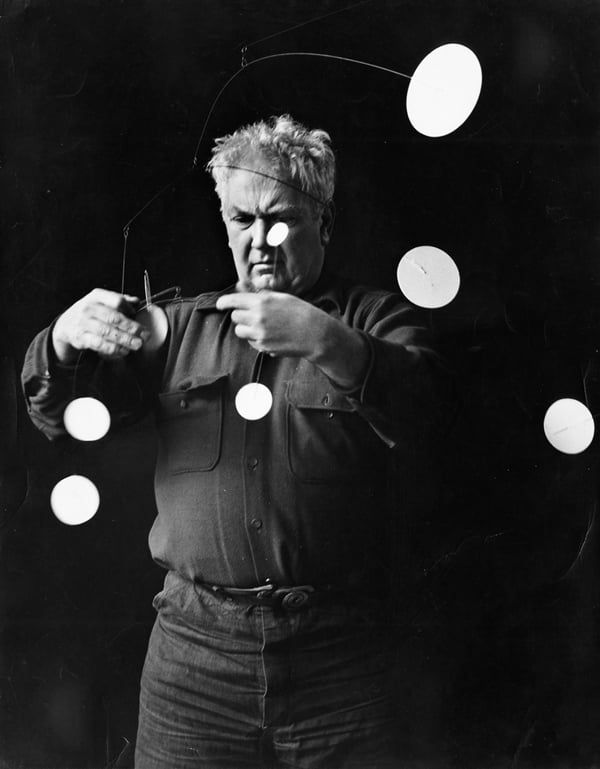
Image: Courtesy of Dominique Lévy.
At eight years old, Alexander Calder already had his own workshop.
The Pennsylvania-born artist, who was trained as a mechanical engineer, had a long career making both monumental and miniature sculptures, as well as floating and standing mobiles. Along the way, the artist befriended the kings and queens of the American and European art scenes.
Here are eight things you may not have known about the artist, who was born on August 22, 1898.
1. Calder was a frat boy.
Calder joined Delta Tau Delta’s Rho Chapter when he attended the Stevens Institute of Technology in Hoboken, New Jersey. Thomas Edison’s assistant was also a fellow member of the brotherhood, and more recently, Matthew McConaughey and Will Ferrell pledged for the fraternity.
2. The army rejected his application to be a camoufleur.
When he wasn’t in class, Calder was busy training with the Naval Section of the Student’s Army Corps.
In the early years of the Second World War, Calder applied to rejoin the battalion as an in-house camoufleur—someone who designs camouflage patterns. His submission was declined, so the artist continued to work on his art, adapting his use of materials to what was available during wartime, since aluminium was scarce.
Calder’s ‘Circus’ on show at the Whitney Museum.
Image: Max Sparber/Flickr.
3. The artist’s circus fascination was instigated by a newspaper assignment.
Calder was enrolled at the Art Students’ League in the 1920s, but also freelanced for the National Police Gazette. The artist was asked to make some sketches to accompany a short story about the Ringling Brothers and Barnum Bailey Circus. His assignment spurred an obsession with such performances that lasted throughout his career.
The Whitney Museum bought the ‘Calder Circus’ in 1982 and it has since been a highlight of the collection.
Photograph of Louise Calder by Man Ray.
Image: Monika Ettlin/Pinterest.
4. Calder met his wife at sea.
After only a few years living in Europe, Calder met his future wife Louisa James on a journey from Paris to New York. Over the course of seven years, the artist built four separate studios in Paris and later he set up camp in Saché, France.
In 1975, 44 years after the couple married, Louisa won the United Nations Woman of the Year Award. When her husband passed away, she declined the White House’s invitation to attend a ceremony in his honor, instead lobbying for the amnesty of all those opposing the Vietnam War.
Alexander Calder, untitled necklace.
Photo: Courtesy Christie’s.
5. His necklace ended up in a thrift store.
We know Calder best for his delicate mobiles that gently move with the wind or a light push. But the artist was also a master jeweler, crafting over 1,800 pieces, most of which he made for his friends and relatives. Peggy Guggenheim famously wore one earring by the abstract artist and one by Surrealist, Yves Tanguy, to express her loyalty to the movements that each artist represented.
In 2005, a woman found the unusual necklace above for $15 at a flea market in Brooklyn. After seeing a newspaper cover concerning a Calder jewelry exhibition, she discovered the necklace was real. In 2013, it sold at Christie’s New York for $268,000.
BMW race car designed by Calder in 1975.
Image: Edvvc/Flickr.
6. There’s a Calder plane…and a Calder car.
Braniff International Airways commissioned Calder to electrify one of their Douglas DC-8-62’s with swishes of bright color. In a book by one of the project’s collaborators, George Gordon, he remembers Calder proclaiming that he didn’t paint toys. When the company assured him that this was a real jet and not just a model, the artist agreed. Calder received two additional commissions from Brainff but unfortunately, after only a few years in the sky, the aircrafts were painted over in an attempt to re-brand the airline.
Hervé Poulain, the French race car driver and auctioneer, had Calder design a BMW for racing purposes. Poulain used the custom-made car in a 1975 endurance race.
Peggy Guggenheim lounging on her bed with Calder headboard behind.
7. Peggy Guggenheim always had Calder nearby.
Mega-millionaire art collector and American socialite Peggy Guggenheim commissioned the artist to design and make a silver bedroom adornment for her New York home. Thin pieces of the shiny metal swerve and spiral up the wall, forming the shapes of fish and underwater plants.
In 1964, the New York Guggenheim held a retrospective of the Calder’s work, and later, in 2003, the museum’s Bilbao space held a similar exhibition.
8. Plans for a Calder Museum were crushed. Twice.
There has been not one but two proposals for a Calder museum, both of which were shot down.
In 1998, it was rumored that a museum dedicated to the artist would settle in 2 Columbus Circle, a competitive piece of Manhattan real estate that now houses the Museum of Arts and Design (MAD). A few years later, works were advancing for a Tadao Ando-designed Calder shrine in Philadelphia, but ultimately, overriding issues with funding meant that neither project was realized.
Related Stories:
The Seagram Building Is Down One Picasso, Up Three Calders
Alexander Calder’s Estate Sued For Blocking Sale of $1-Million Sculpture
How Much Are the Koons, Calder and Warhol Art Cars Worth?
Peggy Guggenheim Documentary by Lisa Immordino-Vreeland Reveals Life of Nonstop Art and Sex